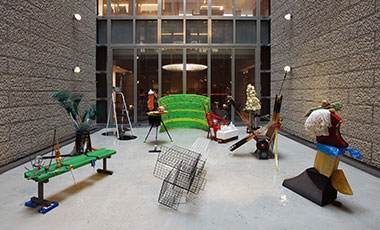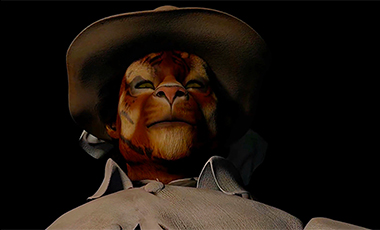

Artist Suh Seung-won poses for a photo in front of his works at Tina Kim Gallery in New York. ⓒTina Kim Gallery.
Artist Suh Seung-won, 77, is considered one of the early members of the Dansaekhwa (Korean monochrome) movement and the founder of the theoretical basis for Korean modernism. He has pursued his 〈Simultaneity〉 series throughout his career, exploring interactions between geometric patterns and backgrounds.
Titled 《Early Works: 1960s to 1980s》, an exhibit showcasing how Suh's rigid geometric forms evolved in "Simultaneity" is currently on view at the Tina Kim Gallery in New York through Oct. 12.
For Suh, "Simultaneity enables the unseen to be seen, ensuring that what is happening in the world of nirvana or beyond dark could be represented through me."
Earlier this year, Suh's work was showcased at the Korea Society in Manhattan from January to April. That exhibition featured Suh's more recent pieces that the New York Times described saying, "They're too square to read as clouds, despite the unmistakable glints of blue peeking through, so the mood remains otherworldly."
While Suh's later pieces are softer with diaphanous colors overlapping, his earlier works currently on view are more geometric and hard-edged.

Installation view of Artist Suh Seung-won's 《Early Works: 1960s to 1980s》 at Tina Kim Gallery in New York. ⓒTina Kim Gallery.
This exhibit presents a wide range of Suh's early artwork to illuminate his aesthetic philosophy as the artist went through experimentation of color, shape and composition.
"The exhibition establishes the importance of Suh's practice and broadens contemporary views of Korean art history in the early 1960s outside of Dansaekhwa and into the movements that grew alongside it from the same contextual stimuli," the gallery said in a statement.
The exhibit sheds light on Suh's "development" period works from the 1960s and "analytical" period in the '70s and '80s.
Suh stated that his work was inspired by his Korean origins.
"My aesthetic roots are planted in Korean traditional culture and its spirit, and I have strived to give a modern interpretation, which is expressed through the spirit of Simultaneity," Suh once said.
He looked for traditional elements in Korean culture such as the architecture of hanoks (traditional Korean houses) and use of hanji (traditional Korean mulberry paper) in construction.

Suh Seung-won, 〈Simultaneity 89-115〉, 1989. ⓒthe artist and Tina Kim Gallery.
Suh was a leading figure in Korean modern abstract art, and founded the Origin Group in 1963 while taking part in the Korean Avant-Garde Association, also known as A.G. Suh was at the intersection of western abstraction and eastern philosophy which inspired Dansaekhwa.
Suh was one of the artists invited to the 《Korea: Five Artists, Five Hinsek - White》 at the Tokyo Gallery in Japan along with Park Seo-bo and Kwon Young-woo, which later provided the inspiration for Dansaekhwa.
Suh has consistently pursued his "Simultaneity" theory for over five decades, seeking a harmonious balance of form, color and space.
"In this pursuit of spatial harmony, the artist pushes the limitations of the canvas plane so far as to draw the viewer's attention to the objects' flat planes, while at the same time representing a window into the viewer's consciousness," the gallery explained.
※ This article was originally published in The Korea Times on 24 SEPTEMBER 2019, and reposted under authority of the Korea Times.
(https://www.koreatimes.co.kr/www/culture/2019/10/145_276080.html)



